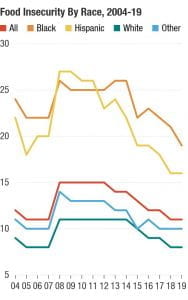Food insecurity is defined as a household-level economic and social condition of limited or uncertain access to adequate food. This is an unfortunate but prevalent problem in our world and nation today. Data also shows that food insecurity happens in some communities more than others. Specifically, data shows that Black and Hispanic Americans are particularly disproportionately affected. Identifying these inequalities/inadequacies is the first step in attempting to correct/fix them. According to USDA data, 19.1% of Black households and 15.6% of Hispanic households experienced food insecurity in 2019. White Americans fell below the national average, with 7.9% experiencing food insecurity.These percentage statistics portray how common food inadequacies are among Americans and how race plays a role. It is difficult for many of us to imagine not having enough food in our stomachs or worrying about our next meal(s), but that is a sad reality facing Americans. Outside of race, food insecurities appear to be directly affected by level of education and ability to work. College graduates experienced food insecurity at a rate of just 5% last year. For those without a high school degree, the rate skyrocketed to 27%. Adults who have a disability — in particular adults who have a disability and are not in the work force — also experience more than two times the rate of food insecurity as adults who do not have a disability. It is interesting to see how a college degree (and lack thereof one) impact rates of food insecurity. I think it is safe to say that there is a direct link between financial situations and food insecurities based on these statistics, with obtaining a job affecting one’s ability to buy and consume food for themselves and their families. I would be interested to know how common food adequacies are in the state of New York and Schenectady. The graph below shows how food insecurity is affected by race.

Works Cited:
https://www.npr.org/2020/09/27/912486921/food-insecurity-in-the-u-s-by-the-numbers



